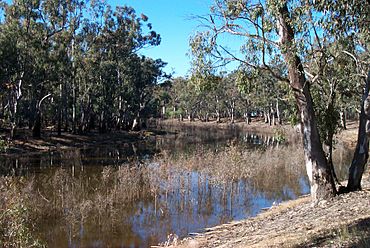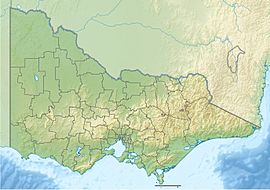Barmah National Park facts for kids
Quick facts for kids Barmah National ParkVictoria |
|
|---|---|
|
IUCN Category II (National Park)
|
|

River red gums along the Murray River, adjacent to the national park
|
|
| Nearest town or city | Barmah |
| Established | 2010 |
| Area | 285.21 km2 (110.1 sq mi) |
| Managing authorities | Parks Victoria |
| Website | Barmah National Park |
| See also | Protected areas of Victoria |
The Barmah National Park is a special natural area, or national park, in Victoria, Australia. It's found next to the famous Murray River, close to the town of Barmah. This park is about 225 kilometers (140 miles) north of Melbourne.
The park is mostly a forest of river red gum trees. These trees grow on a flat area that often floods. You'll also find open, treeless areas with freshwater marshes. The park gets flooded naturally by the river and also by water from irrigation systems.
The Barmah National Park is part of the huge Barmah-Millewa Forest. This forest covers about 60,000 hectares (148,000 acres). It's the biggest river red gum forest in the whole world! The Barmah Forest is also a very important wetland. It's recognized internationally under the Ramsar Convention because of its special natural value. Many birds in the park are protected by agreements with Japan and China.
People love to visit Barmah National Park. It's a great place for camping, walking, fishing, boating, canoeing, and swimming.
Contents
Weather in Barmah National Park
Barmah National Park has a warm, dry climate. It doesn't get much rain, and a lot of water evaporates.
- In January and February, the average high temperature is around 30°C (86°F).
- In July, the average low temperature drops to about 4°C (39°F).
- The park gets about 400 millimeters (16 inches) of rain each year.
- Most of the rain falls in winter, with about 40 millimeters (1.6 inches) per month.
History of Barmah Forest
Long ago, Indigenous Australians, like the Yorta Yorta people, lived in the Barmah Forest. They used the forest to find food, shelter, and materials for their daily lives.
When Europeans settled in the area, the Barmah Forest became important for fishing and logging. Nearby land was cleared for farming and raising animals. New animals like rabbits, foxes, sheep, cattle, and horses were brought in.
People started cutting down river red gum trees for timber around 1870. Logging and cattle grazing were big local industries for a long time. They stopped when the national park was created in 2010. The Barmah muster yards, where cattle were gathered, are now a protected historical site. Cattle grazing was completely stopped in all river red gum national parks in 2015.
The park is also home to many wild horses. These horses came from animals that escaped or were set free in the 1800s. Their numbers grew after more horses were released in the 1950s.
Barmah National Park was first set up as Barmah State Park in 1987. It became a full national park in 2010. This was part of a plan by the Victorian Government to protect important river red gum forests.
In 2010, the Government of New South Wales also made the Millewa Forest, on the other side of the Murray River, a national park. This new park is called the Murray Valley National Park. Together, these two parks form a huge cross-border national park. It covers about 70,000 hectares (173,000 acres) and is managed by both governments and the Traditional Owners. It's the largest continuous red gum forest in the world!
How Flooding Has Changed
A narrow part of the Murray River, called the Barmah Choke, naturally causes water to spill into the Barmah Forest when the river is high. This happens because of a geological fault, the Cadell Fault.
In the past, Barmah National Park would flood naturally almost every winter and spring. River flows were very low in late summer and autumn. But since people started clearing land for farming and building dams, the Murray River's flow has changed a lot. Dams built upstream from the park, starting in the 1920s, have had a big impact on how much water flows and when it floods. Now, the water flow is carefully controlled.
- The Hume Dam started working in 1936.
- The Yarrawonga Weir opened in 1939.
- The Dartmouth Dam began operating in 1979.
Because of these dams, the winter and spring floods are now smaller and don't last as long. Instead, there are more small floods in summer and autumn. These unseasonal floods can be caused by heavy rains or when farmers don't need water for irrigation.
These floods at the wrong time of year can harm the forest and wetlands. They stop the natural drying-out period and mess up how nutrients cycle in the soil. To help, "environmental water" is now released. This water tries to fix some of the problems caused by controlling the river. Managing this water is complex and is mainly done by the Murray-Darling Basin Authority.
Environmental water is supplied to Barmah Forest to:
- Make river red gum trees and water plants healthier.
- Create more homes for frogs and turtles.
- Provide places for waterbirds to feed and nest.
- Help native fish find places to live and lay eggs.
- Move nutrients between the flooded areas and the river.
What Lives in the Park?
Barmah National Park is a river red gum forest. It has tall red gum trees, but no middle layer of shrubs. On the ground, you'll find native grasses, sedges, and rushes. At the edges, the forest blends into a different type of woodland.
The park is a large flood plain and wetland. The Murray River floods it sometimes, both naturally and because of how the river is managed.
Threatened Animals
Many special animals live in Barmah National Park. Some of these animals are considered threatened. This means their numbers are low, and they need protection.
Here are some types of threatened animals found in the park:
- Reptiles like turtles and snakes.
- Many kinds of birds, including migratory birds that fly long distances.
- Fish that live in the river and wetlands.
- Amphibians like frogs.
- Mammals, including some unique Australian species.
Threats to the Environment
After Europeans settled, a lot of land was cleared for farming. Also, the regular burning that Indigenous Australians used to do was stopped. Logging of the river red gum forests was a big industry for many years.
The number of waterbirds and woodland birds in the park has gone down a lot. This is because the flooding patterns have changed.
Some native marsupials, like the rufous bettong and bridled nailtail wallaby, are no longer found in the park. This is thought to be because of introduced animals like rabbits and foxes.
Climate change might also affect the river red gum forests. Some trees have already died because they don't get enough water.
In the past, large areas of the flood plain were covered in a special grass called Moira grass. This grass needed to be flooded for 5-9 months each year. Now, these areas are often covered by other plants like river red gums and giant rush.
The amount of Moira grass has shrunk by 96% in the last 80 years! It might even disappear by 2026 if nothing changes. This is due to less natural flooding, grazing by introduced animals like feral horses and cattle, and invasive plants.
How the Park is Managed
The Victorian Government declared Barmah Forest a national park in 2010. The park is managed by Parks Victoria and the Traditional Owners, including the Yorta Yorta people.
For many years, the Murray River's flow was controlled mainly for farming. But now, people understand how important it is to let water flow naturally for the environment. Studies show that river red gums need specific floods to survive and grow. Waterbirds also need certain flood conditions to breed successfully. River flows are also very important for native fish. So, managing water flows in the Murray River will be a key part of protecting these forests in the future.
Controlling fires is also important. More frequent fires, which might happen with climate change, could harm bird habitats and help invasive plants and animals spread.
Parks Victoria has a plan to improve Barmah National Park. They want to:
- Time floods to help plants grow and provide homes for breeding waterbirds.
- Control invasive plants.
- Remove introduced grazing animals like horses, deer, pigs, and goats.
The main goals are to protect the wetlands, increase the amount of Moira grass, and make the habitat better for all native plants and animals in the park.
News About the Park
In late 2018 and early 2019, during a big drought, there were news reports about starving feral horses in national parks, including Barmah National Park. At Barmah, some local groups started feeding the horses on land next to the park. Inside the park, Parks Victoria began humanely putting down horses that were in very poor condition.
In April 2019, Parks Victoria announced a four-year plan to remove over 500 feral horses from the park. They also plan to control other introduced plants and animals. They aim to remove 100-250 horses each year. Some horses might be trapped and rehomed if new owners can be found. The rest will be shot by professional shooters. After four years, the plan will be reviewed. The final goal is to remove all feral horses from the national park.
Parks Victoria explained that the law does not allow horses to stay in the national park. They said that if they don't control feral horses, they won't be able to protect threatened species as required by law. They stated that "Difficult choices need to be made to reduce the severe damage to the important natural values of Barmah National Park." They also mentioned the animal welfare risks from too many feral horses.
However, some local groups disagree. They say there aren't as many feral horses as Parks Victoria claims. They believe that the environmental flooding, not too many horses, is causing the problems. They are against removing any horses.



